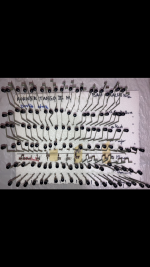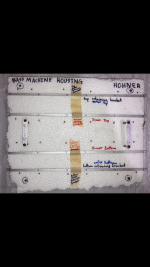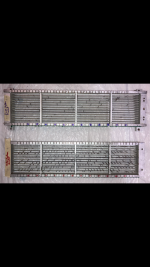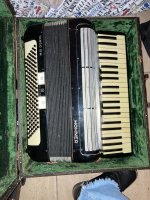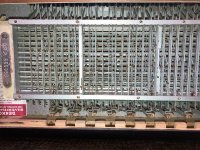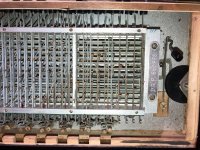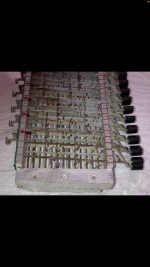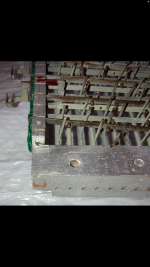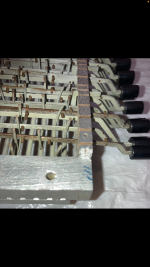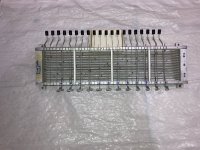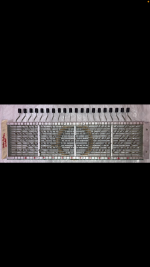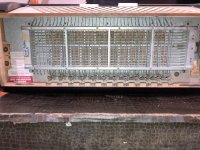hoag
Member
Howdy!
I have lurked on these forums for a while, and this is my first post. Shout outs to the people who approved my account activation.
I'm restoring a Hohner Tango III M, which was made in Germany. I was told that it was built and bought in the 1930's, but I have not researched this yet. It had many issues upon purchase, many of which I have resolved. It still has a few problems that require attention. I am a veteran luthier, and novice accordion repairman. My current project is the bass machine, and it is just a bit beyond my understanding. This is where I'm hoping you all come in!
Many of the bass buttons were depressed within the machine, when in a resting state. I'm not exactly sure what that meant. The machine also had some jumped pins, which I was able to confidently diagnose. It was the G dominant piston, and the Eb major piston. They were constantly sounding when opening and closing. After locating which pistons were out of place, I decided to disassemble the mechanism for a de-rusting and deep cleaning, using the guidance found throughout these forums. It desperately seems to need the old steel wool treatment. I was also able to confirm that the bass side pallets were not the culprit, after removing the bass machine. They all need a refacing, but my paper solution works until I receive my order from Carini. All is going smoothly, and I have disassembled most of the bass machine. I still have the combs and their structural brackets left to disassemble, but that is a job for daylight.
(TLDR) Here are my questions. How can I understand which piston nubs correspond with which comb teeth as I reassemble the bass machine? How do I know which piston nubs to place above or below which comb teeth? Can anybody offer a resource detailing the design for this specific model? How do I make sure that my combs spring back to their proper positions, as they should?
This is my first bass machine disassembly, please be gentle. I know now that I should have taken a photograph of each row before removing it. I've been taking photos of everything except for this critically important detail. I thought I was doing everything well until halfway through, when the thought hit me. "I know where everything goes, except where the nubs sit. Oh shit."
Thanks in advance.
I have lurked on these forums for a while, and this is my first post. Shout outs to the people who approved my account activation.
I'm restoring a Hohner Tango III M, which was made in Germany. I was told that it was built and bought in the 1930's, but I have not researched this yet. It had many issues upon purchase, many of which I have resolved. It still has a few problems that require attention. I am a veteran luthier, and novice accordion repairman. My current project is the bass machine, and it is just a bit beyond my understanding. This is where I'm hoping you all come in!
Many of the bass buttons were depressed within the machine, when in a resting state. I'm not exactly sure what that meant. The machine also had some jumped pins, which I was able to confidently diagnose. It was the G dominant piston, and the Eb major piston. They were constantly sounding when opening and closing. After locating which pistons were out of place, I decided to disassemble the mechanism for a de-rusting and deep cleaning, using the guidance found throughout these forums. It desperately seems to need the old steel wool treatment. I was also able to confirm that the bass side pallets were not the culprit, after removing the bass machine. They all need a refacing, but my paper solution works until I receive my order from Carini. All is going smoothly, and I have disassembled most of the bass machine. I still have the combs and their structural brackets left to disassemble, but that is a job for daylight.
(TLDR) Here are my questions. How can I understand which piston nubs correspond with which comb teeth as I reassemble the bass machine? How do I know which piston nubs to place above or below which comb teeth? Can anybody offer a resource detailing the design for this specific model? How do I make sure that my combs spring back to their proper positions, as they should?
This is my first bass machine disassembly, please be gentle. I know now that I should have taken a photograph of each row before removing it. I've been taking photos of everything except for this critically important detail. I thought I was doing everything well until halfway through, when the thought hit me. "I know where everything goes, except where the nubs sit. Oh shit."
Thanks in advance.
Attachments
Last edited:

